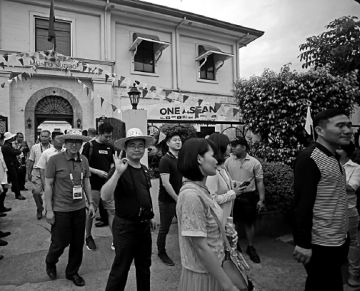
Asean delegates visit the Museo Sugbo during the Cebu leg of the meetings. Business leaders say that the successful holding of the Asean leg in Cebu last week is proof that Cebu is safe and secure.
TRAVEL ALERT, REPORTED TERROR THREATS
Following Cebu’s successful hosting of meetings for the Association of Southeast Asian Nations (Asean) 2017 Summit, local business leaders found reports of alleged terrorist threats in Central Visayas hard to believe.
Cebu Chamber of Commerce and Industry (CCCI) President Melanie Ng, who attended one of the Asean meetings last week, said she can say that Cebu is safe and secure.
“Let’s continue to exert all efforts to be vigilant and report any suspicious activities to the proper authorities immediately,” she said in a text message to Cebu Daily News.
“It is unfortunate that another travel advisory was issued. We will continue our efforts to make sure our tourism and trade activities will not be affected by it,” said Ng.
Last Sunday’s travel advisory was the second issued by the US Embassy in Manila in less than six months. The first one issued last November warned Americans about going to the southern portion of Cebu due to threats of kidnapping.
Glenn Soco, president of the Mandaue Chamber of Commerce and Industry (MCCI), described the latest US advisory as quite unexpected and alarming.
“Our region has always remained peaceful and secured, especially since Cebu just successfully hosted the Asean Summit (meetings). However, this will keep us and our police authorities to be more vigilant and proactive,” Soco said.
Close to 500 high-level finance and security officials from Asean-member states gathered in the cities of Cebu and Lapu-Lapu from April 3 to 7 in meetings leading up to the Asean Summit, which the Philippines is hosting this year.
For Cebu Business Club (CBC) President Gordon Alan Joseph, this is a “wake-up call” that will unfortunately affect tourism.
“This is worrying and we should not be complacent. We need to tighten up security and police visibility,” Joseph said.
Alice Queblatin, president of the Cebu Association of Tour Operations Specialists (Catos), pointed out that while the travel advisories should be taken seriously and that it should make the public more cautious in planning outdoor activities, they are only directed at a specific nationality.
“Our other productive markets like Japanese, Korean, European and (other members of the) Asean do not change travel plans because of travel advisories,” she said.
Edilberto Mendoza, Catos immediate past president, said there might be a decrease in the number of American visitors coming to Cebu during Holy Week or throughout summer break, but it would not be significant.
“American tourists do not comprise the majority of our foreign guests coming here. There might be a slight decrease, but it is not that remarkable as Asians are still our major visitors,” Mendoza said.
Data from the Department of Tourism in Central Visayas (DOT-7) showed that American tourists in Cebu ranked third in terms of visitor volume from January to November 2016 at 133,285.
Koreans and Japanese nationals are Cebu’s top two visitors with 711,644 and 314,997 tourists coming over during the same period, respectively.
The US ranked fourth in all of Central Visayas, contributing 169,193 tourists during the nine-month period in 2016.
Visitors from Korea were pegged at 758,451; followed by Japan at 328,954; and China at 210,450, making them the region’s top three tourists in terms of volume.